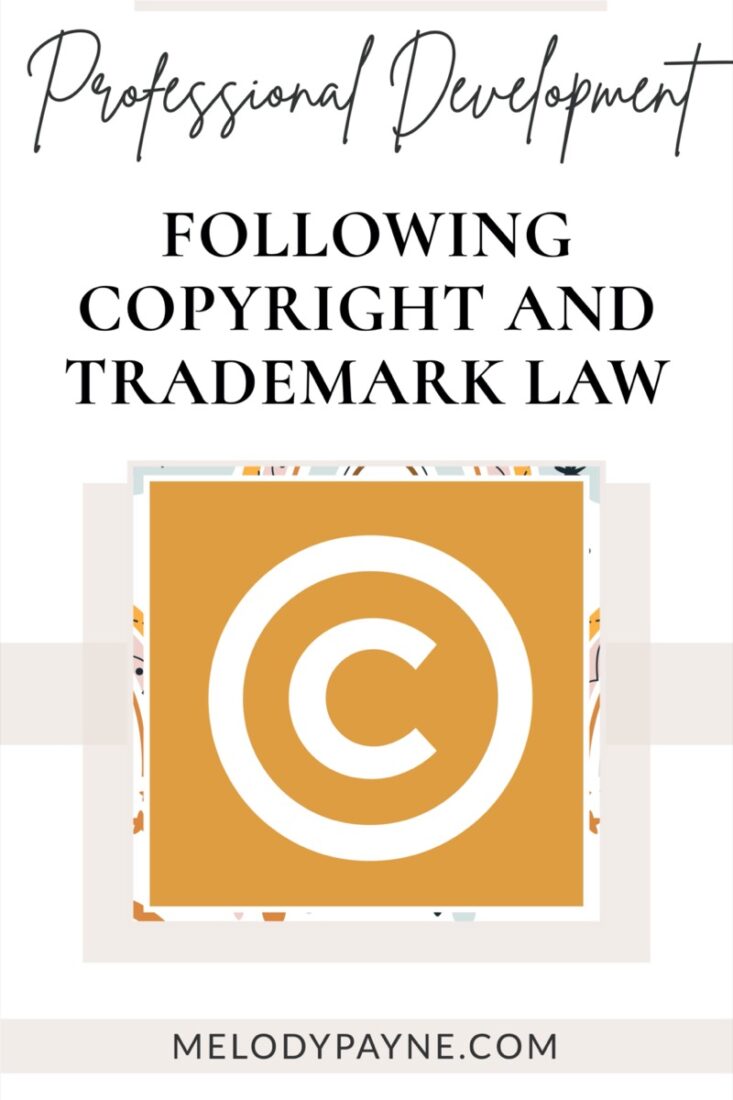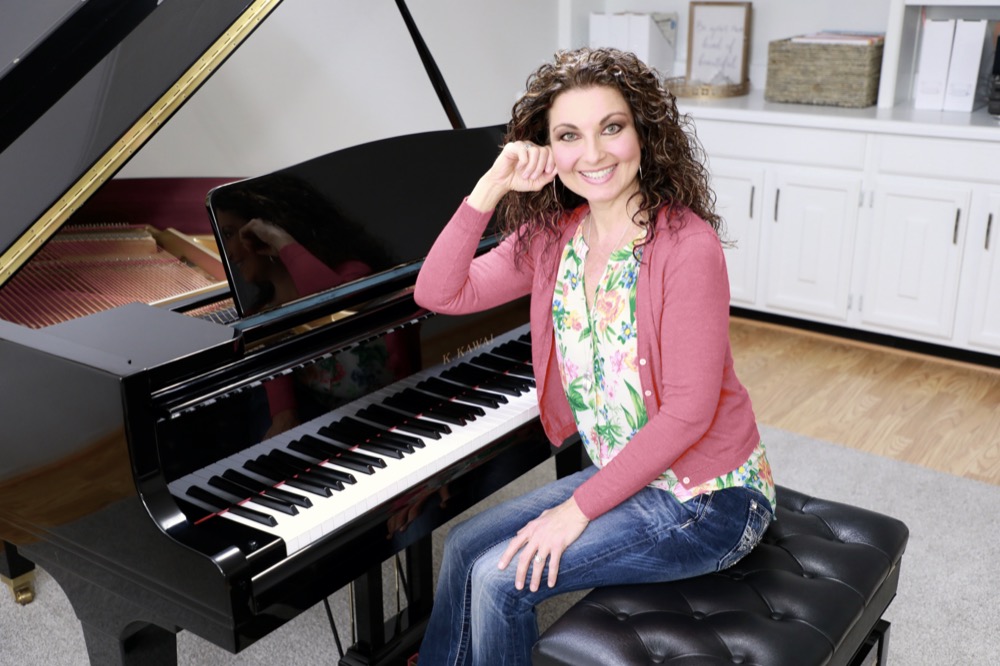How to Follow Copyright and Trademark Law in the Piano Studio
This post may contain affiliate links. If you purchase something through an affiliate link, I will receive a small commission at no cost to you. For more information, read the disclosure statement here.

Copyright and trademark law in the piano studio: These aren’t topics you’d particularly expect on a piano teaching website, right? But with more and more of our businesses going online every day, and with more and more of us designing piano teaching resources for our own studios and to give away or sell to other teachers, these are topics that absolutely cannot be overlooked and ignored.
For example, did you know that a work is protected by copyright law the moment it becomes tangible (put on paper)?
Did you know organizations such as Disney, Harry Potter, the Olympics, and Bitmoji don’t allow their characters to be used commercially?
How about this: Did you know that if you infringe on someone’s copyright you could be fined thousands of dollars? https://www.copyright.gov/title17/92chap5.html#504
In this video, we’re going to talk about Copyright and Trademark Law in the Piano Studio.
Watch to see how important they are, and how we can ensure that we’re following the law at all times when designing piano teaching resources.
Video Transcript
Before we begin, I need to share this disclaimer:
***This is not legal advice. I am not an attorney.
***Do your own research, follow the law, and consult your attorney for legal guidance on trademark and copyright.
Now we can get started 😊
In this video, we’re going to talk about trademark and copyright.
First of all, what is copyright? Let’s go to the best source on copyright: The US Copyright Office at https://www.copyright.gov/
According to their website, “Copyright is a type of intellectual property that protects original works of authorship as soon as an author fixes the work in a tangible form of expression. In copyright law, there are a lot of different types of works, including paintings, photographs, illustrations, musical compositions, sound recordings, computer programs, books, poems, blog posts, movies, architectural works, plays, and so much more!”
Because of copyright protection, we are not allowed, by law, to copy anyone’s resources. This includes someone famous, or someone we’ve never heard of before. As soon as that person puts their idea on paper, it is THEIR idea and is protected by copyright law.
Anything that is published is protected by copyright law, whether it is published by a famous company such as Disney, or published by a business run by one person. That also includes this course, this lesson, and this slide that you’re viewing right now!
To follow copyright law, remember this:
Do not copy other people’s resources, ideas, paragraphs (remember how much our high school teachers emphasized that we shouldn’t plagiarize? It’s still 100% true!). Use your own incredible creativity to come up with your own amazing ideas!
Next, let’s talk about Trademark.
What is Trademark? To help us understand Trademark, let’s hear from the United States Patent and Trademark Office website at https://www.uspto.gov/
According to the USPTO, “A trademark can be any word, phrase, symbol, design, or a combination of these things that identifies your goods or services. It’s how customers recognize you in the marketplace and distinguish you from your competitors. It could be a word, slogan, design, or combination of these. It could even be a sound, a scent, or a color.”
I’m going to say a few words, and I want you to say out loud the first thing that pops into your mind when I say them:
- “The golden arches”
- (Did you think about burgers and fries? The stylized M is their trademarked logo.)
- How about this one: “America runs on Dunkin’”
- (Are you craving coffee and doughnuts right now?)
- Here’s one more: “Just do it!”
- (Did you picture the logo with the swoosh on your favorite pair of athletic shoes, or maybe someone wearing a shirt with that swoosh, playing sports?)
Now that you have a good mental image of what Trademark is, you’ll understand why we are not allowed to use trademarked characters, ideas, companies, etc., in our resources, such as Bitmoji, Disney, Harry Potter, The Very Hungry Caterpillar, the Olympics, etc. This breaks the law and is not OK.
Yes, there is a LOT of clipart of these characters out there for sale. It’s everywhere, it’s cute, and it can be tempting!
However, the VAST majority of it was created unlawfully, so don’t use it.
Do your homework. Know what you can and can’t use in your resources. Just because it is out there, doesn’t mean we can use it.
If you’re unsure whether a character, idea, company, etc. is trademarked, visit trademarkia.com and search for it. If it’s there, it’s trademarked and off limits.
Here are 6 important things to remember about copyright and trademark:
Number 1:
Anything that is published is automatically protected by copyright, so you are not allowed to use it “as inspiration”, to copy, or to use in your resources in any way.
Number 2:
I can’t stress this enough: Brainstorm your own ideas and use your own incredible imagination to come up with amazing resources. Infringing on someone’s copyright or trademark is against the law and you could face serious fines (or much worse) if a company files a complaint against you or sues you! I’ve seen it happen, it’s absolutely terrible, and I definitely don’t want it to happen to you.
Number 3:
Speaking of copyright, add your copyright to every page, every flash card, every part of your resource. My copyright that I use on resources is Copyright © the year My Name. All rights reserved. On a Mac, you can get the © symbol by typing Option+G. On a PC, you can get the © symbol by typing Control+Alt+C.
Number 4:
If you’re curious to know more about a company or brand or website’s products, characters, or images, search the company’s website for brand use guidelines. The vast majority of the time, we’re not even allowed to mention them or their companies in our resources.
Number 5:
Don’t go by what you see online. There are SO many copyright infringements all around us, and more are being put out there every day, so please do your due diligence and do the right thing.
Number 6:
Check it before you use it: Visit the Trademarkia website before assuming you can use an image, logo, slogan, picture, or other identifying piece of a company’s brand. My best advice is very simple: Just don’t go there, with regards to copyrighted and trademarked items, and you will be fine!
Final Thoughts on copyright and trademark law in the piano studio
Be sure to thoughtfully and carefully follow copyright and trademark law in the piano studio in all you do. Whether you’re designing resources to give away or sell, whether you’re composing, arranging, or downloading and assigning new pieces to your students, always follow the law.
More articles on creating your own resources
- How to Create Professional Recital Programs – The Easy Way!
- Create Quick & Easy Word Art Gifts for Your Students
Our best music worksheets bundle if you don’t want to create your own resources:
Don't miss out!
Follow on Facebook and Instagram, join the best Facebook group for piano teachers, and subscribe to the newsletter to get helpful teaching tips, resources, and tutorials delivered straight to your inbox every week.
Melody Payne
Melody Payne
Welcome!

Hi! I’m Melody Payne, a pianist and piano teacher, educational resource author, a fun-loving wife to the most wonderful and talented hubby I could ask for, and a lifelong learner who loves to share. I want to make your life as a music teacher easier by writing and sharing helpful and relevant music teaching articles, and by creating educational resources with your very own students in mind. If you are a parent who wants to enroll your child in piano lessons, I’d love for us to get started building those skills that can give your child a lifetime of musical enjoyment!

